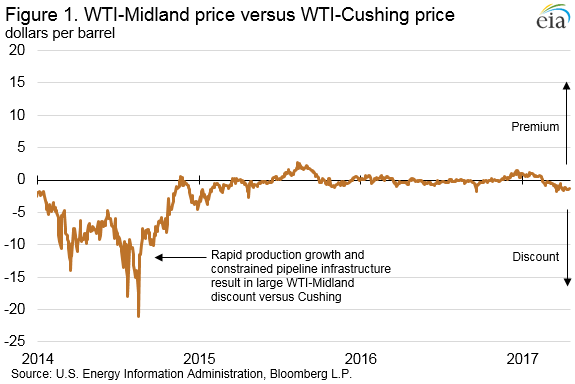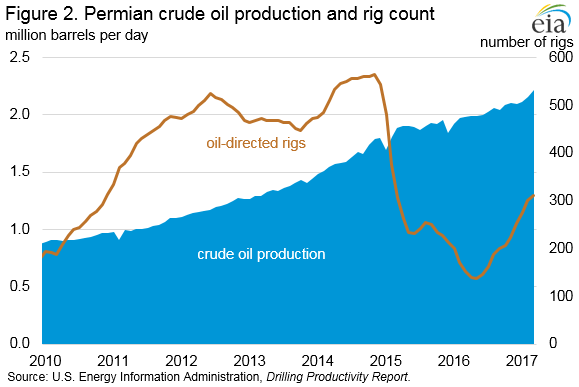US: New Pipeline Capacity And Infrastructure Changes Can Accommodate Increasing Permian Crude Oil Production – Analysis
By EIA
Increasing crude oil production in the Permian basin of western Texas and eastern New Mexico is filling available pipeline capacity, putting modest downward pressure on West Texas Intermediate (WTI) crude oil priced at Midland, Texas compared with WTI at Cushing, Oklahoma.
However, the Midland versus Cushing discount, which recently widened to more than $1 per barrel (b), is unlikely to be either as large or as persistent in 2017 as it was following the rapid increase in Permian production over 2010-14. Pipeline capacity expansions and other market changes now underway appear poised to facilitate the efficient disposition of higher volumes of Permian crude oil.
Compared with other oil producing regions, the Permian has a large number of productive geological formations stacked in the same area, including the Wolfcamp, Bonespring, Spraberry, and Yeso-Glorieta formations. The Permian’s other favorable characteristics are in-region refining capacity, close proximity to large refining centers on the Gulf Coast, and existing pipeline infrastructure.
Crude oil production in the Permian grew by 593,000 barrels per day (b/d) between January 2010 and January 2014, more than could be accommodated by in-region refinery capacity and pipeline capacity. This situation resulted in large price discounts at the crude gathering and transportation hub in Midland, Texas compared with Cushing, Oklahoma, indicating that the marginal barrel of crude oil was moving out of the region via a mode of transport more expensive than by pipeline. In 2014, WTI-Midland averaged a $6.94/b discount to WTI-Cushing, compared with a $1.68/b average discount the prior year. However, as new and expanded pipeline capacity was added in 2014 and 2015, WTI-Midland’s discount to WTI-Cushing narrowed, falling to an average of only $0.07/b in 2016 (Figure 1).
In contrast to trends in the Bakken and Eagle Ford plays, where production generally declined throughout 2015 and 2016 as oil prices fell significantly below their 2011 through mid-2014 level, production in the Permian Basin continued to grow over these years. With the rise in oil prices from their low point in early 2016, EIA’s April Short-Term Energy Outlook (STEO) expects crude oil production growth in the Permian to accelerate. EIA’s April Drilling Productivity Report (DPR) indicates a total of 310 oil-directed rigs active in the Permian, 158 more than the same time last year. The DPR also estimates crude oil production in the Permian at 2.2 million b/d, already 232,000 b/d higher than the same time last year (Figure 2).
Pipeline infrastructure in the Permian is now better equipped to handle new production than it was in 2014. Several of the pipelines that came online to accommodate rising Permian production in 2014 (Magellan’s BridgeTex pipeline, Sunoco Logistics’ Permian Express pipeline, and Plains All American’s Cactus pipeline) are undergoing expansions set to come online later this year, adding approximately 340,000 b/d of capacity.
In addition to expansions of existing pipelines, Enterprise Product Partners is building a new Midland-to-Houston pipeline with a capacity of 450,000 b/d that is also expected to come online later this year. Other pipeline expansions are planned for gathering systems and intra-Permian pipeline infrastructure to bring increasing production to the larger pipeline origin points like Midland. After 2017, several more new pipelines and expansions are planned or are in the planning stages that could carry potential further increases in Permian production.
Other developments in the Gulf Coast have also opened up new markets for Permian crude oil. New and expanded pipelines along the Gulf Coast completed in the past several years resulted in Gulf Coast markets becoming more interconnected. These developments allow Permian crude oil production to make its way to refining centers in Corpus Christi and Houston in Texas, St. James in Louisiana, and points in between.
The increased interconnectedness of Gulf Coast crude oil markets also increases access to crude oil export infrastructure, which has become a more relevant advantage with the lifting of export restrictions on domestically produced crude oil in December 2015. Access to international markets provides an additional outlet for increased Permian production.
With expanded pipeline takeaway capacity and access to more domestic and international buyers, increased volumes of Permian crude oil production would likely be disposed of without the significant price discounting that occurred in 2014.
U.S. average regular gasoline and diesel retail prices climb
The U.S. average regular gasoline retail price rose over one cent from the previous week to $2.44 per gallon on April 17, up 30 cents from the same time last year. The Gulf Coast price increased five cents to $2.24 per gallon, the Rocky Mountain price increased over four cents to $2.38 per gallon, the East Coast price increased over two cents to $2.40 per gallon, and the West Coast price increased one cent to $2.88 per gallon. The Midwest price fell two cents to $2.34 per gallon.
The U.S. average diesel fuel price rose two cents to $2.60 per gallon on April 17, 43 cents higher than a year ago. The West Coast and Midwest prices each increased two cents to $2.88 per gallon and $2.54 per gallon, respectively, while the Rocky Mountain, East Coast, and Gulf Coast prices each rose one cent to $2.65 per gallon, $2.63 per gallon, and $2.46 per gallon, respectively.
Propane inventories fall
U.S. propane stocks decreased by 0.7 million barrels last week to 39.6 million barrels as of April 14, 2017, 29.3 million barrels (42.5%) lower than a year ago. Gulf Coast and Rocky Mountain/West Coast inventories decreased by 0.6 million barrels and 0.2 million barrels, respectively, while East Coast inventories fell slightly, remaining essentially unchanged. Midwest inventories increased by 0.1 million barrels. Propylene non-fuel-use inventories represented 6.4% of total propane inventories.

